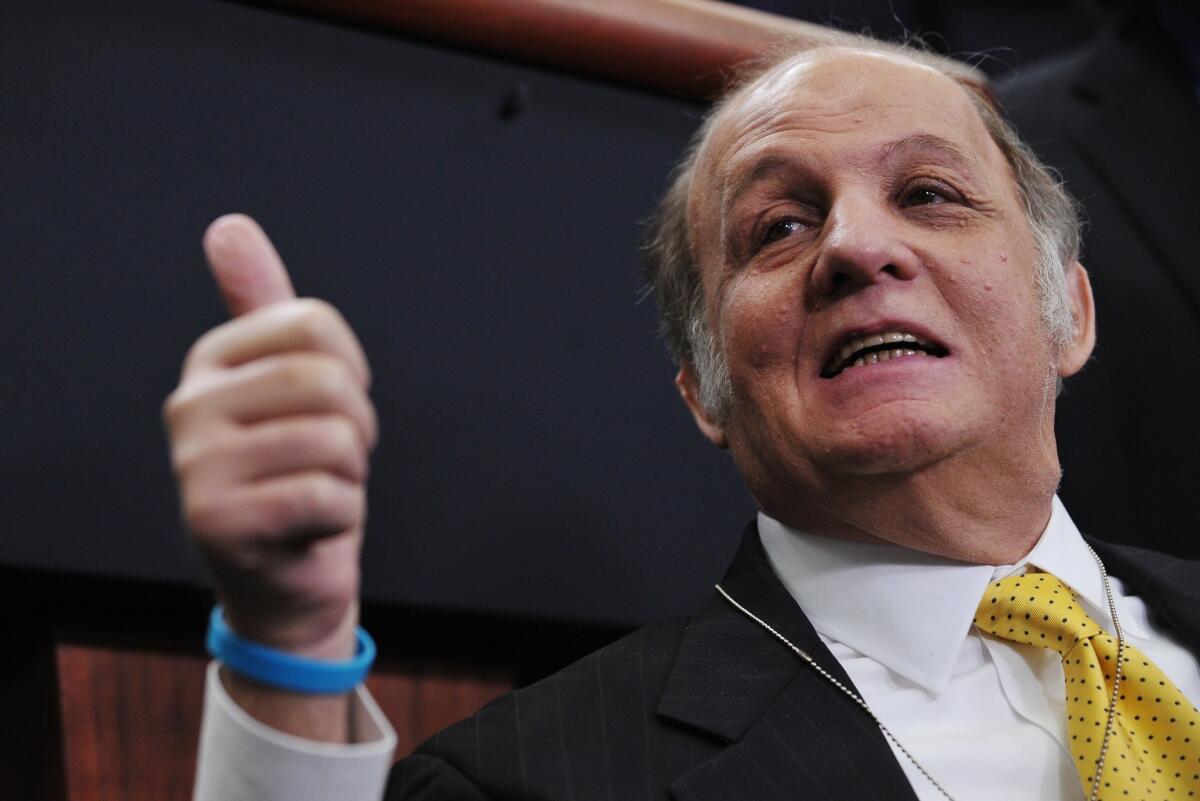James Brady dies at 73; former Reagan spokesman, gun-control advocate

- Share via
James S. Brady had been presidential press secretary for less than three months when a deranged would-be assassin fired a volley of shots at Ronald Reagan on the sidewalk outside a Washington, D.C., hotel.
The president was wounded by a ricocheting bullet that lodged in his chest; Brady took a direct hit on the left side of his forehead, the bullet passing through the right side of his brain.
Television commentators declared Brady dead that day in 1981. Although those reports were erroneous, Brady was, in fact, seriously wounded by shooter John W. Hinckley Jr. and was left partially paralyzed, with permanently slurred speech. He mostly used a wheelchair from that day on.
------------
FOR THE RECORD
James Brady: In the Aug. 5 Section A, a caption with a photo that accompanied the obituary of James Brady misidentified a man wounded alongside Brady in the 1981 assassination attempt on President Reagan as Secret Service Agent Timothy McCarthy. McCarthy also was injured in the shooting, but the man pictured is Washington, D.C., police officer Thomas Delahanty.
------------
For the next three decades, Brady would become a potent symbol of the dangers of handgun violence and, along with his wife, Sarah, a leading campaigner for tougher gun control laws, including one that bears his name.
On Monday, James S. “Jim” Brady died in Alexandria, Va., after “a series of health issues,” according to a spokeswoman for the Brady Campaign to Prevent Gun Violence, the organization he founded. He was 73.
The efforts of the former White House spokesman and his wife recorded their biggest victory in November 1993, when Congress, after years of debate, passed the Brady Handgun Violence Prevention Act. The largest change in federal firearms regulation in a generation, the law required background checks and a five-day waiting period for purchases of handguns from federally licensed dealers. The waiting period and background checks were aimed at preventing felons and people with mental problems, like Hinckley, from obtaining guns.
Brady’s ties to senior Republicans, including Reagan, who endorsed the bill three years after leaving office, were critical to its passage.
So was his personal testimony.
During a hearing before the Senate Judiciary Committee in 1989, he was asked about the argument that a waiting period would be too much of an inconvenience for gun buyers.
“I need help getting out of bed, help taking a shower and help getting dressed, and — damn it — I need help going to the bathroom,” he said. “I guess I’m paying for their convenience.”
When President Clinton signed the bill into law in 1993 in an emotional ceremony attended by the Bradys, Jim described its adoption as “the end of unchecked madness and the commencement of a heartfelt crusade for a safer and saner country.”
In 1998, the waiting period was replaced by the current instant background check system.
Over the years, background checks have blocked roughly 2.1 million sales to felons and other people who are ineligible to buy guns, according to the Justice Department’s Bureau of Justice Statistics.
Whether the checks have actually reduced gun crime has been unclear. The law applies only to sales by licensed firearms dealers, not to secondary sales by individuals, which researchers say are widely used by criminals to get guns. Efforts to expand the background check system to cover those sales have failed several times, most recently last year, when a bill proposed by President Obama fell to a Senate filibuster.
On Monday, Obama paid tribute to Brady’s “remarkable legacy of service.... An untold number of people are alive today who otherwise wouldn’t be, thanks to Jim.”
That Brady recovered enough to be a leading national advocate for gun control was testimony to his “iron will” and “the best medical team in the world,” according to Sarah Brady.
In the wake of the shooting on March 30, 1981, he underwent more than six hours of emergency surgery to remove bullet fragments from his head. Hospitalized for nine months, he nearly died several times from blood clots. The damage caused him to lose some control over his emotions and have short-term memory loss.
But his playful personality — the humor and fun-loving mischievousness that had made him a favorite of the press corps — remained intact. As he endured years of intense and painful physical therapy, he jokingly referred to his therapists as “physical terrorists” and insisted that his wounds hadn’t wrung all the fun from life.
It wasn’t just a bullet from Hinckley’s revolver, bought for $29 in a Dallas pawn shop, that turned the couple into gun-control activists.
Four years after Brady was shot, his 6-year-old son Scott found what he thought was a toy gun in a family friend’s car and pointed it at his mother. It was a fully loaded pistol, much like the one that Hinckley had used.
The incident spurred Sarah to start working with Handgun Control Inc., a legislative lobbying group that later was later renamed the Brady Campaign to Prevent Gun Violence.
Hinckley, who had a history of mental problems, was found not guilty by reason of insanity in 1982 and was committed to a Washington mental hospital. Last year a federal judge granted Hinckley, now 59, up to 17 days a month to visit his mother in Virginia.
James S. Brady was born Aug. 29, 1940, in Centralia, Ill., to James and Dorothy Brady. His father was a railroad yardmaster. During high school, Brady ran track and played football and tennis but had his greatest success as a swimmer. He also became an Eagle Scout.
While attending the University of Illinois, he studied communications and political science and hosted a children’s show at the school’s TV station.
His senior year he married Sue Beh and they had a daughter, but Beh left him after about two years. In the 1987 Brady biography “Thumbs Up,” Beh said the couple had married too young.
Before graduating with a bachelor’s degree in 1962, Brady worked as a field representative for Sen. Everett M. Dirksen (R-Ill.).
He was running Republican campaigns in Illinois in 1970 when he met his future wife, Sarah Kemp, who was the finance liaison for the Republican Party. They married in 1973.
In the 1970s, Brady held a variety of governmental aide positions, including serving as an executive assistant to Sen. William V. Roth Jr. (R-Del.) and as an assistant to Defense Secretary Donald Rumsfeld.
When former Texas Gov. John B. Connally unsuccessfully challenged Reagan for the Republican presidential nomination in 1980, Brady served as his press secretary and then joined the Reagan campaign. By then, Brady had gained a reputation for combining candor and razor-edge wit with shrewd judgment.
In “Thumbs Up,” Gary Schuster, former Washington bureau chief of the Detroit News, said Brady “gave the Reagan people a sense of direction about Washington. Most of the players had no idea how it worked. Brady knew Capitol Hill.”
In dealing with the media, Brady “was honest.... When he didn’t know, he said so,” Schuster said.
After Reagan won the presidential race, he asked Brady to be his press secretary. His main job, according to Reagan biographer Lou Cannon, “was to beef up an issues research system that had failed to bridge the candidate’s increasingly visible knowledge gap.”
Reagan’s comments on some issues could tax even Brady’s considerable resourcefulness and patience. One celebrated incident began during a campaign swing after Reagan was heavily criticized by environmentalists for saying that trees put out more sulfur dioxide than cars.
Days later, when the campaign plane was flying over a forest fire, Brady looked down and yelled, “Killer trees! Killer trees!” The comment made its way into print, and Brady was briefly grounded by the campaign’s chairman.
Humorous byplay was central to Brady’s approach to life and work. He gave animal nicknames to everyone, including himself. He was the Bear, probably for his bear-like shape. He called his wife Raccoon.
On inauguration day 1981, Brady walked into his White House office and found a bulletproof vest left for him by Jody Powell, President Carter’s press secretary. Pinned to the vest was the note “Dear Jim, It’s not the bullets that get you in this job, it’s the ants and the gnats.”
Of course, a bullet meant for Reagan did hit Brady. The severity of his wounds made him unable to function as the White House spokesman even though Brady remained the official press secretary for all eight years of the Reagan administration. In 2000, the White House press briefing room was renamed in Brady’s honor.
In a joint statement Monday, 12 successive presidential spokespeople, including current press secretary Josh Earnest, noted that Brady “had a true affection and respect for the press, relished a good sparring with the front row, and was an unfailing defender of the president and the value of a free press. Jim set the model and standard for the rest of us to follow.”
Brady became involved in fundraising campaigns for a number of groups that work on behalf of the disabled and served as vice chairman of the National Organization on Disability.
As a fundraiser, Brady was effective, his wife wrote in her memoir, “A Good Fight,” because he “could get through to people no one else could reach — rich and famous heads of corporations — and talk them into contributing.”
In 1999, he and his wife moved to Rehoboth Beach, Del. Brady made a rare return to Washington in 2004 for Reagan’s funeral.
About a decade after the attack, Brady said in an interview that he could work himself into “a good rage” over his fate but that was “essentially, a negative exercise. Play the hand that’s dealt you.”
In addition to his wife, Sarah, Brady’s survivors include their son, Scott, and his daughter, Melissa, from his first marriage.
Nelson is a former Times staff writer.
David Lauter, the Times’ Washington, D.C., bureau chief, contributed to this report.
More to Read
Start your day right
Sign up for Essential California for the L.A. Times biggest news, features and recommendations in your inbox six days a week.
You may occasionally receive promotional content from the Los Angeles Times.







